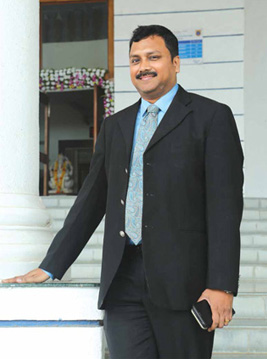
Subhrarabinda Birabar—a heavyweight of India’s logistics industry—travels through his tenacious journey of how, as a youngster, he overcame challenges of hailing from small town and with dogged determination,conquered every step that he countered to achieve his goal
If rebelliousness, impulsiveness and ambition were to merge together and manifest into one individual, the name of that person would be Subhrarabinda Birabar or Subhra as he’s fondly called by his family and friends.
Currently the Group CEO of Canada based Sandhu Group of companies, he’s guiding the fortunes of its various global enterprises-in logistics, iron ore, real estate, cement, hotels and resorts, to name a few. Subhra has played a key role in the development of some important ports including Dhamra and Kakinada. He is also member of five core committees on port infrastructure of the CII (West India). Subhra’s career journey proves what really matters is a burning desire and a belief in your own self. If you have it, you too can make it.
Hailing from a middle-class family, Subhra’s parents wanted him to become a computer engineer. His heart, however, was not in it. He left engineering, tried several things before finally realising that he’d love to study Supply Chain Management in the Logistics industry, and that too from IIM Ahmedabad. He hasn’t looked back ever since. Having worked in several companies including Ranbaxy, VISA Group, L&T, Dubai Port World, Jafza India Group, Gammon Infrastructure and Arshiya Ltd. in his almost 23-year long career, Subhra personifies how small-town boys are doing big in India today. In this interview, he explains how small things in life count more than anything else
I come from Odisha-one of the poorest eastern states of India—next only to Bihar, from the bottom. But I was fortunate that I had better exposure to life than many others because both my parents came from a very good educational background. My father, being a bureaucrat, and mother, principal of a school, they made sure I got good education and grooming in Bhubaneswar where we lived. In those days, most parents thought about four professions only—you become either a doctor or an engineer or a civil servant. And if you failed to get into any of these three, then you become a probationary officer in some bank. That was all. Management education, per se, was not even perceived as an option because private sector jobs were not regarded very highly. Being the eldest son of my parents, they wanted me to become an engineer.
After plus two, I got admission into a computer engineering course which was quite a big thing in those days. I’m talking about 1989. I was doing my first year when, I realised that that was not what I wanted to do. I gave up engineering and came back home. I wasn’t able to fathom a lot of things and didn’t know what to do next. I was turning out to be quite a rebel in the family. Then my parents said, if not engineering, do something at least in the science stream-because science was considered better than arts. So, I completed my BSc, and then got into management.
I had a chance reading of Business India and Business World magazines around that time. I came across an interview of Mr Ratan Tata where he talked about some of his new business initiatives and I got hooked onto that. I felt, why I should not go into the corporate world because if India had to progress fast, it needed private sector involvement at an aggressive pace. I could see that government had limited funds and unless the private sector put in money in big infrastructure projects, things wouldn’t change. But my parents thought very differently because they both came from government backgrounds. They didn’t like the commercial profitability considerations of the private sector and disapproved the fundamentals of free market economy. They wouldn’t look at profiteering as the primary motive of work. So, there was a sort of clash of ideologies in the family. So, after completing my graduation in science, I went for my management education in Delhi and thereafter moved to IIM Ahmedabad for my PG Diploma in Logistics Management.
Because at that particular point of time, I realised the importance of logistics in a vast country like India where, on the one hand, our population was growing at an alarming rate and on the other, distribution and delivery of products and services was turning out to be a huge problem in many parts. Since everybody requires something to eat and something to wear and that required a huge amount of money to be transacted, I could see that the logistics sector was poised to grow exponentially in the years to come. After all, if India has to grow, the logistics chains have to be in place so that food and other livelihood products are available throughout the country. This growing realisation made me choose Logistics Management.
It was pretty good and the more I studied it, the more intensely I realised the challenges this sector was facing. I found that in the majority of cases, there were loopholes in the logistics of the supply chain. It was here that things were going haywire and people were not getting the products. You must have seen frequent media reports as to how food grain is rotting at one place, onions and tomatoes rotting at another place and people dying because of starvation in Bihar, Orissa and such other places. So, all that affected me deeply and that’s why I felt I must do it to make a difference.
I realised the importance of logistics in a vast country like India where, on the one hand, our population was growing at an alarming rate and on the other, distribution and delivery of products and services was turning out to be a huge problem in many parts
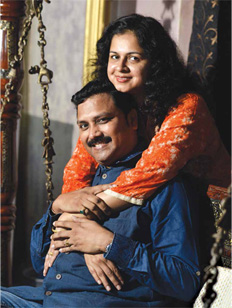
Earlier people didn’t know its importance but lately it’s becoming a sought-after thing. Due to the growth trajectory seen in manufacturing, retail, FMCG as well as ecommerce industries, the logistics sector is poised to grow at a CAGR of over 12 per cent in the next couple of years. No wonder, more and more students are going for it. Though when I did it, there was no such thought in my mind that I’ll be making money out of it because, as I was telling you, I was more concerned about the challenges India’s logistics sector was facing and I wanted to contribute something from my side like a social entrepreneur.
Actually, at IIM-A, I put the course aside for some time because I wanted to experience the intellectual spark in its environment. It’s something that you have to feel to describe it. The way its teaching faculty looks at a problem, the way they explain it and help you understand it—is very different. They’re very analytical. They re-instilled the faith I had in my abilities but which was dwindling because I wasn’t sure whether what I was doing was right: Was I becoming a rebel without a cause? But the way they allowed me to express myself, I realised my rebellion wasn’t without a cause. I learnt a lot of things and I’ll remain indebted to IIM-A for all of that.
Yes, I got into Eli Lilly Ranbaxy. It was a joint venture of the world’s second largest American pharmaceutical company, Eli Lilly, and Ranbaxy, India. I was made in-charge of logistics for north Bihar. The Dewas factory of Ranbaxy was producing drugs in collaboration with Eli Lilly and they had to reach all over India. I was heading two divisions and my job was to ensure that these drugs from the Dewas plant reached the remotest areas in Bihar and nearby places. It was a supply-chain management job. But after about a year, I began feeling that this wasn’t the place I’d like to continue for long because of certain societal issues. In 1996, I left this job. Then I moved into international trading. I joined London-based VISA Group, as Deputy Manager. They deal with international trade and marketing of cement and steel plant raw material from China, South Africa, Indonesia and such other places to India. I was there till 1998 and this experience taught me the basics of the international shipping logistics. It was around that time that the Port Development Division of Larson & Toubro, called International Seaports (India) Ltd, was getting into a joint venture with the largest rail road operator of America and the largest trans-ship owners of Thailand. I was recruited for one of their port projects. We signed the first project of `1000 crore in Dhamra in the Eastern coast of Odisha. Then we were doing another deepwater port project in Kakinada (Andhra Pradesh). In West Bengal also, we were trying to do a port project. So, that’s where I got my real exposure to the shipping and logistics industry. I worked in L&T for about four years (1998-2002) and learnt a lot.
By 2002, I’d developed a good understanding of the port sector and the bulk market. So, I thought, why shouldn’t I now move into the container market? Somehow, I turned out to be the right person at the right place because the Dubai Port World also wanted to enter the Indian market at the same time. They had a joint venture with a firm, J M Baxi, in Mumbai, for their company, Visakha Container Terminal Ltd. They took me to set up their container terminal facility in Visakhapatnam and I was given a seven month target to make that operational. With our detailed planning, we could make it operational in just six months. So, people around recognised the ability to deliver. Subsequently, I was pulled into the Dubai Port World. I went to Dubai to work for them. I was looking after their entire free zone operations. Subsequently, I was sent back to India, after two years, as head of their free zone operations in South-East Asia. I slowly started feeling complacent because, at 36, I had become the Director and the India-head of Jafza India Group (2006-11). There were no new challenges coming up, because, unfortunately, Dubai was going through a bad phase around 2009 due to the real estate bubble burst in Dubai World’s real estate subsidiary, Nakheel. Though I was drawing a very hefty salary and trying to do many things, nothing much was happening on the ground because there were financial restraints. At that time, somehow the feeling of swadeshi took over me. I thought why I shouldn’t work for Indian entrepreneurs? That was the point when I joined Gammon Infrastructure Projects Ltd as Director, heading their entire port sector under the dynamic leadership of Mr. Abhijit Raja who was owner of the entire group.
The development of adjoining roads and proper infrastructure around ports/ SEZs/ airports/ ICDs is challenge number one. The second relates to policy measures about this sector. You have to have a coherent policy because infrastructure around ports and SEZs and airports go hand in hand
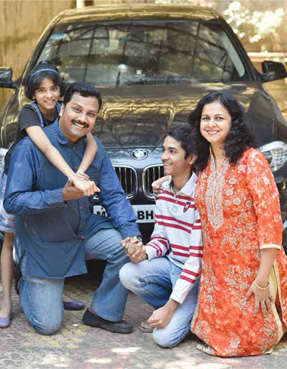
Out of 23 years of my career, for almost 13 years, I’ve worked in Mumbai. Four years I worked in Chennai and for about two years, I was in Dubai. From Gammon’s India container terminal project at Mumbai Port, we could acquire two new ports at that time-one in Paradip and another in Goa during my tenure. We were running those facilities but there was a slump in Indian business and an overall slump in the container related business over the last three years. So, we had to come out with some new solutions. By the time I left it, we could achieve a world record of getting 6400 cars shifted in one day in a vessel carrier. But after three and half years at Gammon, the same thing happened again, and I started looking for some new challenges. I joined Arshiya International Ltd as its CEO from 2015 to March 2016. It was India’s first fully functional Free Trade Warehousing Zones (FTWZs) developer company at that point of time. Now there is one more, Chennai-based Balaji Logistics. But when I joined it, the company was doing badly. Financially, it was in the doldrums. But within one year, I doubled its revenues from Rs. 5.5 to Rs. 10 crores per month. Similarly, its container utilisation was under 600-700, but I turned it to around 1200 which was then a record. They had never achieved it in the ten years of existence. But again, the problem with them were their NPAs and other losses. I could see the financial health of the company was not improving beyond a point. So, I felt, it was again time for a change.
I then moved to my present employers, the Sandhu Group of companies—a Canadian conglomerate—in May this year as its Group CEO in Mumbai. They’re into diverse areas—from Logistics to Real Estate and from Hotels to Finance. Since they’re basically from Punjab, they want to put up a facility in logistics to create a free-zone SEZ and real estate infrastructure. The real estate infrastructure will suit those who work in such zones, having multiple meeting rooms and business facilities. Having rich experience, they want to develop this entire zone. But it’s a very challenging task because you’re creating something out of nothing.
I’m trying to help them in the realisation of their vision to becoming market leaders in these areas. They trust me with the investment plans. So, it’s a challenging role which gives you a kick to do lots of things in a very uncertain business environment.
You plan various business verticals and accelerate growth through geographical expansion. Since they’re cash-rich and you’re sure about funds. You’re not working in a struggling company. But that’s not all. They’re also looking positively at every opportunity which crops up. Should we invest there, should be invest here? So, lots of discussions take place. For instance, if you want to get into logistics, maybe a logical conclusion would be trading, or housing because you’re creating huge mega logistics infrastructure facilities so that people could stay somewhere. Lot of foreign dignitaries who’ll be coming there will need a hotel, a conference room and such other things. So, you have to plan all that. But the good thing is that you know what the group’s competencies are because they have the global exposure, so international logistics fits into their outlook naturally. The sky is the limit but all we try and do is to relate and integrate things.
It’s been very good. It’s the seventh month and we have the entire road map ready. Questions like re-structuring and how and where the international headquarters will be are being looked into. Right now, we’re working from Mumbai, though travelling all over. But my travelling has reduced a bit because with video conferencing and other things, you can talk to all your team mates in different parts of the world.
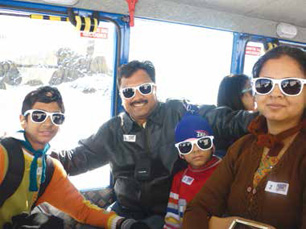
The challenges are two-fold. One relates to infrastructure because you can create the best of facilities in a 600 acre area for logistics but as soon as you come out of it, then what? You need good roads and other transportation infrastructure. This is where the government’s role comes in. But I’m happy to say that I’m seeing a lot of change happening in the last two years or so. A lot of dynamism is coming into this sector because of the initiatives of our honourable Prime Minister Narendra Modi and his Minister for Road Transport, Highways and Shipping, Nitin Gadkari, who understand the problems of this sector and know how to solve them. So, development of adjoining roads and proper infrastructure around ports/ SEZs/ airports/ ICDs is challenge number one. The second relates to policy measures about this sector. You have to have a coherent policy because infrastructure around ports and SEZs and airports go hand in hand.
Two reasons: One is our inherent habit of taking things for granted. Even if we create an SOP, we don’t follow it. You have to follow SOPs strictly in the logistics industry. The ‘chalta hai’ attitude must go. Secondly, we have very poor road infrastructure and poor connectivity and inadequate air and seaport capacities. If you compare our logistics sector with that of developed countries, you realise we do not have the economy of scale due to fragmentation of the industry and lack of skilled labour and manpower. But remember, America is a 200-years plus-old democracy whereas we’re just 70 years, so things will take some time to reach to that level, but our Prime Minister is working very hard to bridge this gap fast and make India the most competitive player in the global economy.
We badly need spiritual education in our curriculum. It’s important to learn how to combat stress in today’s times. If you have a little bit of spirituality, keep it alive as it’ll help you fight depression. Also, all days are not going to be sunny. Hope for the best, but be prepared for the worst
Most certainly, it’s the chairman of L&T, AM Naik. He’s an engineer. He has never studied management but he’s managing an almost 20 billion dollar company. When he took over, L&T’s turnover was just one billion dollar. But if you look at his life history to know how he evolved, you realise how much hard work he had put in to reach to this stage and the only thing that kept him going was that perennial hunger: How to do better? Because I was once part of L&T, I have seen him from close quarters. He is now 75 plus and yet puts in 18 to 20 hours a day. Most of the time, L&T recruits only from IITs, but he was the only non-IITian and just because there was a constant hunger in him to prove himself that he was better than the IITians. I am also inspired by the stories of late Dhirubhai Ambani, as also Gautam Adani, founder of the Adani Group, especially the way he established the most modern Mundra Port.
I would say, despite the fact that they came from small towns and ordinary families, they had a hunger inside which kept propelling them to greater heights. But we have many around us in the field of sports today. Look at the achievements of India’s Cricket team Captain M S Dhoni who comes from Jharkhand. Look at P V Sindhu and others who’ve done us proud during the recently concluded Rio Olympics.
The corporate gender gap in India has been pretty unfavourable to women all these years. But things are changing and changing for the better. Corporates have started recruiting more women because they’re good at multi-tasking, are sincere, dedicated and have a very stabilising presence as compared to their male counterparts.
We’re a very small and compact family. I’m heading towards 44, having been a rebel in the family, I had a love marriage and my wife is from Gujarat. She’s a Charted Accountant and much more stable and thoughtful than I am. She was working as the finance head of a reputed business group but not any longer. We have a son who’ll be appearing for 10th standard exams this year and a daughter who is studying in Class 4. We live in Mumbai.
I’ve got two younger brothers. One is in Delhi and the youngest is in Louisiana in USA. My parents don’t like to stay at one place for more than two months because they feel more comfortable in Bhubaneswar. After all, we have most of our friends, relatives over there. Whenever they come over to Mumbai, they find I’m busy with my office and kids have to go to school, they get bored after some time. So, we keep going there.
We badly need spiritual education in our curriculum. It’s important to learn how to combat stress in today’s times. Honestly, even I’d have gone haywire if I hadn’t stuck to my spiritual beliefs. If you have a little bit of spirituality, keep it alive as it’ll help you fight depression. Also, remember, not all days are going to be sunny. Hope for the best, but be prepared for the worst.
We all romanticise it in Bollywood movies—love and marriage across religions, caste and regions— glorifying it as the victory of good over evil, but in real life it does not always work out so. Crossing the hurdles of religion, caste and states to be with the person you love is not easy even in this 21st century. Subhrarabinda Birabar and Soni Laila defeated all prophets of doom to prove that true love triumphs over all barr
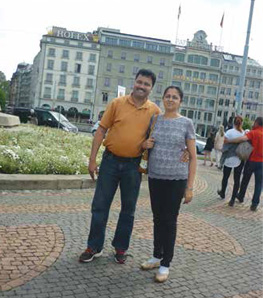
They say love is blind. In fact, that’s the very foundation of most inter-faith marriages the world over. But in India, falling in such blind love is easy, but getting married to the man you love is not. More so, if it involves not just inter-religious but inter-state and inter-caste sensitivities too.
And, that exactly was the case with Soni Laila and Subhrarabinda Birabar when they fell in love and decided to tie the knot before any family drama could separate them. Recalling those early days and how they finally got married, says Soni, “Oh my God, our marriage was one hell of an affair!!! You can imagine (how difficult it would have been for) a Hindu boy meeting an Aga Khani, Ismail girl, through a common friend and deciding to get married within just three months of their first meeting!”
That’s because, in our kind of marriages, families are not okay if one partner is Hindu and the other Muslim. Moreover, they also say, a girl marries not just the spouse, but his whole family and if they’re not happy, then it’s anybody’s guess as to what her life would be like.
So, what was her biggest worry when, knowing it all, she decided to go for it? Says Soni, “More than anything else, I was deeply concerned about the approval of my in-laws because, after all, they were going to be my family.” Why didn’t she explore the idea of going through a love-cum-arrangedkind-of marriage? “See, in our case, it didn’t look very bright at that stage; so we decided to go through a court marriage,” Soni confesses.
But wasn’t that a pretty difficult choice? “Oh yeah, that decision was certainly very tough for both of us because we were going through the most challenging times in our relationship and, moreover, we were in the course of setting up our small nest. We both were in good jobs. Both were Taureans. Both were strong-headed and both wanted to grow. We therefore managed to set-up our grahasti from scratch and on the strong foundations of our love and trust.”
However, that was not all. “Later we also took on the responsibility of the two younger brothers of Subhra, my two devars,” Soni points out, adding, “Honestly speaking, this one step boosted our self-confidence manifold and made us ready to face any challenge, howsoever big or small.”
So, how did it all begin? After all, she’s a Gujarati and Subhra, an Odishi? Even their family backgrounds were very different? Soni reminisces, “That’s very true. In fact, I was the eldest among three sisters in a close knit family. Both my parents were into business in garments. Right from the beginning, I had a flair for mathematics, accounts and numbers. As I grew and took B Com, chartered accountancy became an automatic choice. As I came from a Gujarati business family, I always dreamt of being in the business world. In fact, my maternal grandfather used to be a very successful businessman in Penang, Malaysia. And, by virtue of that, our annual holidays in Malaysia used to be great bliss. Incidentally, since my birthdays would always come during the summer holidays, they were celebrated with lots of surprises and gifts in Malaysia,” she reminisces with nostalgia.
Going further down the memory lane, Soni adds, “Childhood was indeed the happiest time of my life. Though I chose to become a CA, my younger sisters preferred the medical profession. While the younger one became an Ophthalmologist, the youngest is a dentist and they’ve also got married to doctor husbands. In fact, one is a Cardiac Surgeon while the other is a Specialist in Medicine and they both have settled in Malaysia.”
But then, post-marriage, why did she leave her job as, being a chartered accountant, she was doing pretty well? “Oh yeah,” admits Soni with a twinkle in her eyes, adding, “I was indeed doing pretty well in my job as I was heading the finance and accounts of many companies. But, post marriage, quite often, I would take breaks for this or that, and that didn’t seem right. So, after a while, I thought of taking a sabbatical for a year or so, to spend some quality time with my kids. Hence I left my job recently. Right now, I’m enjoying the best part of my life with my son and daughter. But, as they say, you can’t keep a fish out of water for long. So, I too will be back in action pretty soon,” she says, rather confidently.
How does she spend her time with her kids and what are they doing? Says Soni, “Our son Shouryadipta will be appearing for his Class 10 exams and daughter Shoumya is in Class 4 in Ryan International School in Chembur (Mumbai) and, trust me, managing them is much tougher than a corporate job, though Subhra may disagree. Lol!” she says with a teasing smile on her face while Subhra just nods his head, amused.
What would they like their kids to become? Both Subhra and Soni are in full agreement. Say Subhra, “We both want them to be independent and be an asset to the society. We want them to pursue their own dreams rather than doing what we want.”
Does she regret not being able to go back to work because of her growing kids? Promptly comes her reply, “I really love working. In fact, work is worship for me. Thankfully, my kids are now grown up and so, I think, it’s just the right time for me to go back and utilise my talent and skills.”
What does she think about the recent trend where most girls, working as professionals, want to delay their marriage so that they may advance their career dreams? “No, I don’t agree, though it’s true to some extent because a new value system is certainly emerging in our society where some working girls think along those lines under the influence of their rather westernised thinking,” Soni says thoughtfully.
However, on second thoughts, she adds, “It’s not her age that matters so much but how loving and encouraging her husband is that motivates a girl in her career. I know many who married early and are doing exceedingly well because of the emotional support they get from their husbands and in-laws.”
But doesn’t the family suffer when both parents are working and have little time for kids? She nods in agreement, adding, “It’s true but to some extent only because there is a positive side to it too: kids quickly become independent. The important thing is not the quantity but the quality of time you spend with your kids.”
Post marriage, what were her early experiences, with Subhra changing jobs every two to three years? “That’s true,” she says, adding that Subhra had quite a few change of locations in his job which were demotivating to her career, but since they had decided to be together always, she didn’t mind resigning and looking for new assignments.
I was indeed doing pretty well in my job as I was heading the Finance and Accounts of many companies. But, post marriage, quite often I would take breaks for this or that, and that didn’t seem right. So, after a while, I thought of taking a sabbatical for a year or so, to spend some quality time with my kids
But did Subhra help her in household chores in those early days? “Oh yes, he did, whatever little time he could manage. In fact, apart from the usual hiccups, everything else we took in our stride,” she recalls, smiling.
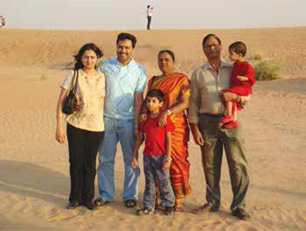
Who calls the shots at home? “See, he only takes the major decisions but leaves all home-related matters to me and generally doesn’t interfere,” but continues she, “Subhra has a habit of punching holes at times,” Soni adds, joking.
What are her hobbies? “I love painting and gardening and we both love going on holidays, at least twice a year. Besides visiting different parts of India including Odisha, MP, J&K, Tamil Nadu, Gujarat and Maharashtra, we’ve also visited some exotic foreign locations in Malaysia, South Africa, Thailand, France, Italy, Spain, Switzerland, Norway and Dubai. In fact, we loved Switzerland a lot.”
But they had stayed in Dubai also for about two years, so how was that experience? Prompt comes her reply, “Dubai was too mechanical. But I love Chennai and Mumbai for their excellent work culture.”
So, if she’s to give some advice to youngsters on what keeps a marriage going, what would it be? “Honestly, no preaching to youngsters as they’re far more intelligent. But I’ve only one request: don’t move away from each other just because you have some difference of opinion. Work on those differences and iron them out by removing the creases of your ego, especially by the better half, that is by the one who’s more well-off,” she says. And, then quickly adds, rather thoughtfully, “See, differences are bound to be there in any relationship but you’ve got to accept them because you both come from two different backgrounds and had different upbringings.”
How important is money? Says she, “It’s important as everybody weighs you on your wealth and the position you hold in an organisation, but it’s not everything. It’s just a catalyst and you should know how best to utilise it in making your life beautiful.”
What are her plans for the future? Smiles she, “Plans are aplenty. I’ve written to the CA Institute for reforms in the courses conducted by ICAI. Back in the corporate sector, post GST-era, I’d like to see and contribute my bit in doing anything to make India become an economic superpower in the near future. Also, along with a corporate career, I’d like to do something in the field of education and career counselling for the young. Apart from that, I’d like to build some old-age homes for our senior citizens. We badly need them, especially in our metros,” she says, adding, “Please wish me good luck.”
And, what is the philosophy of her life? “Live and let live. Make this world a better place for all,” Soni concludes with a broad smile on her radiant face.
By Pradeep Mathur